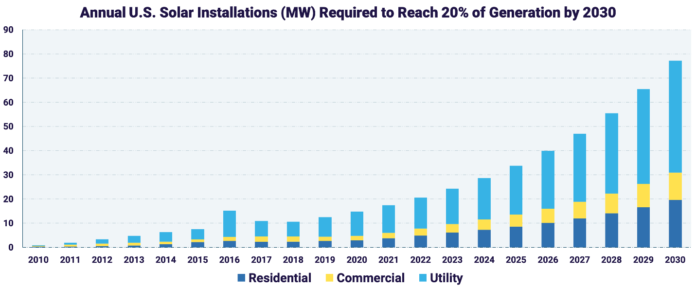As part of the first steps into the “Solar+ Decade,” the Solar Energy Industries Association (SEIA) has released a roadmap that puts solar energy on a path to reaching 20% of U.S. electricity generation by 2030.
The roadmap is a 10-year strategic vision that highlights both opportunities and systemic challenges the industry will need to overcome to reach its goals, says SEIA.
“The Solar+ Decade represents opportunity and a paradigm shift as we transform energy use in America,” says Abigail Ross Hopper, president and CEO of SEIA. “When we hit this goal, by 2030, we will more than double our workforce and add $345 billion in private investment, all while offsetting electricity sector emissions by 35 percent. But we can’t get there on momentum alone. We’ll need policies, alliances and action from every member of the industry to make these goals a reality.”
Earlier this year, SEIA laid claim to the 2020s as the Solar+ Decade to signify the leading role solar and its partners will play in “reimagining our energy landscape,” the group says.
According to SEIA, to achieve 20% solar by 2030, the industry should consider the following:
- Collaborations: A cohesive solar industry and external partnerships will be key to the industry’s success. Partnerships with storage, wind and other technologies will be critical to advance grid infrastructure and change how we generate, distribute and consume energy.
- Market Accelerators: Economic and political forces outside of the solar industry – such as energy storage, carbon reduction goals and the further electrification of our economy – have their own momentum, and solar will need to continue to ride this wave of success.
- Market Levers and Policy Drivers: Reaching 20% solar by 2030 will depend on a variety of factors, including the industry’s ability to find new opportunities for cost reductions and to move or change policies that can drive growth. The industry will need to streamline permitting challenges to reduce costs, continue its push on net energy metering and other state-level policy in emerging markets, and pass an extension of the investment tax credit to continue growth.
- Growth Management: The industry must consciously build a strong foundation to support itself. We must proactively address cybersecurity, recycling and land use challenges, as well as grid modernization and the inclusive, equitable distribution of opportunities in solar.
“As the solar industry prospers, we must be thoughtful about who’s benefiting from solar and the enormous economic and climate benefits it will bring,” adds Hopper. “Together, we can show that the Solar+ Decade is a story of inclusive growth that will both lift our communities and tackle our pressing climate challenges.”





I sell to businesses, farms and non profits. As far as I am concerned the biggest inpediment to successfully getting the entities whose solar system costs under $1mm is work hard at getting realistic financing. I ask many other salespeople how they funded a project that cost $250k. Almost always the answer is they paid cash . That does not work for the majority of small business The financial industry has to get real and join in by offering loans under $500k at decent lower rate and terms or the industry will never ever make thier goals. All industry entities… Read more »